SEO Keyword Research and Mapping
SEO Keyword Research and Mapping
Last Updated / Reviewed: 15january2025
Execution Time: 2-8 hours

Goal : Finding high-volume keywords that are easy to target (i.e. there aren’t many other websites that target them too) and which suit your website’s niche, grouping them according to search intent and demand, as well as creating an incipient sitemap based on the aforementioned keyword groups.
Ideal Outcome : Creating a comprehensive keyword strategy your SEO specialist(s) and content marketer(s) will be able to use in the months to come.
Pre-requisites or requirements : N/A
Why this is important : Although definitely not the only element that ensures excellent Search Engine Optimization, keyword research is by far the most important SEO task. A great keyword strategy can give you a
competitive advantage against large players in the market, determine what to work on next,
who to hire, and how much to invest. You can use your keyword strategy to inform the structure of your site and even define your content marketing calendar.
Where this is done : In your browser, in a keyword research tool, as well as in a spreadsheet that will help you organize all the keywords you find.
When this is done :
- Before you (re)create your website.
- It should also be done recurrently, at least once a year, to refresh your website’s SEO.
- Before rolling out your SEO or content marketing strategy.
Who does this : The SEO Specialist or a V/A you’ve trained to do help you with keyword research and mapping – but if you haven’t hired either one (or an agency to handle your digital marketing), you’re on your own 🙂
Before starting: Understand the SEO keyword mechanism
- SEO keywords are the words and word phrases Internet users search when they want to find a product or solution to their problem, a piece of information, etc.
- The better you optimize your website with these keywords, the more likely it is that you will land among the first options provided by a Search Engine’s Result Page.
- Keep in mind that SEO is not just about the keywords – they are a crucial element in the optimization process, but not an exclusive one.
- Keyword research can be performed with a lot of tools. Up until not very long ago, Google’s Keyword Planner was the top choice among SEO professionals. However, Google recently started to limit the number and quality of their suggestions, especially for users who don’t invest money in AdWords campaigns.
- As a result, SEO pros have started using other tools more frequently. Some examples include KWFinder (free with limited capabilities), SEMRush (free with limited capabilities, excellent when paid), and SEOBook’s Keyword Tool (decent free tool). In this SOP, we will use KWFinder, as it provides the best quality-price ratio.
Environment setup
- Sign up for Semrush and KWFinder or ask for access if your company already has an account.
- Make sure you have Excel, access to Google Sheets, Libre Office Sheets, or any other similar tool
- Arm yourself with patience. This is not a difficult process, but it can be quite time-consuming. Yet, the more time you invest in it, the better your results it will yield.
Run an in-depth keyword research
For the purpose of this SOP, we used an example of a business that sells wooden cutlery and all things wooden.
Consequently, the entire SOP is created around the same idea, just to give you an example of how it a keyword research and mapping process should look like. Of course, all of the steps described hereon will be adjusted to suit your particular business needs.
- Go to google.com
- Think of what your future clients would search for to find your business. For the purpose of the examples in this SOP, we will imagine we are looking for a wooden bowl.
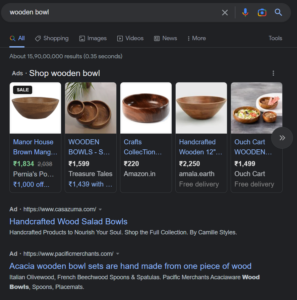
- Now pick out a website that is ranking organically.In this example we found a website called wooden twist.

4.Now copy this website and open it on similarweb and click on competitors tab to find out similar websites.



6.Now lets take one website , in this example we will take https://woodentwist.com/ an example to pull keywords and put it in semrush.

7.No click on Organic research on the left and pull up the top organic keywords.
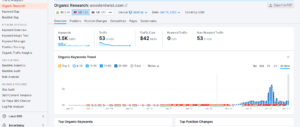
- After you pull up the top organic keywords list add a Keyword Difficulty filter and sort the keywords by easy and very easy.
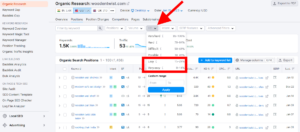
9.After you compile a list of keywords we will sort them by another layer of filter to get the easiest and most promising keywords, By putting those keywords in kwfinder.
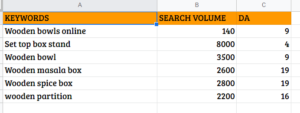
- No put the keyword in kwfinderd and look for the top 10 ranking domains. If you find a domain with domina authority > 20 then thats an easy keyword and you should add it to your list..

In the below diagram you can see that we have a domain with DA (domain authority) of 19 so this is a low hanging easy to rank keyword.
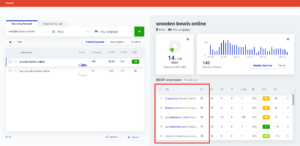
- No similarly you have to perform the same task for all the keywords and put them in a Google Sheet. You can perform the same task on multiple competitor websites and find hundreds of keywords.
- Remember, patience is key in this process. Ideally, you should be searching for keywords and creating a comprehensive list. You want as many of them as you can find! If your competition is not doing this, you will have a tangible competitive advantage if you create a great keyword strategy.

Keyword Mapping
- Now sort the keywords from the master list as
- Homepage Keywords
- Collection Page Keywords
- Product page Keywords
- Blog Keywords aka Informational Keywords
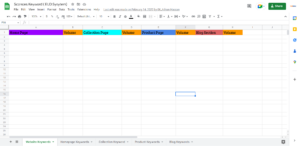
2. Use this Google Sheet and put the specific keywords accordingly to your Niche/ Business. In this sheet we have taken example of a business that sell sconces , The same concepts apply to any niche.
Home Page Keywords
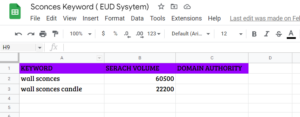
Collection Page
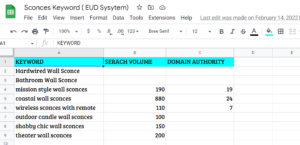
Product Page

Blog Keywords
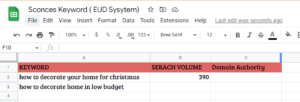
Use your keyword map to make business decisions
Once you are done with your keyword research and mapping, you can stop there and move on to actually using these on your website. However, if you want to push things even further and reap all the benefits of your hard work,
could use your keyword buckets to make business calculations (and take decisions based on them). you
From the total monthly volume of visitors on your website to a very broad idea of the revenue your business could generate, there’s a lot you can do with each of the buckets you have just created. Here are some of the steps to take if you want to learn more about your potential market and the user intent you should focus on the most:
- First, create a row for “Total Monthly Volume”. Select the cell where you want your total monthly searches to be displayed, go to the “Functions” feature of Google Sheets, select “SUM”, then select the cells you want to add up. The spreadsheet tool will automatically display the sum.
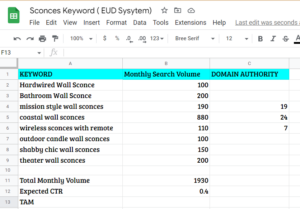
2. Secondly, create a row for “Expected CTR of #1 Result” (where “CTR” means “Click-Through-Ratio”). This is usually between 35% and 40%, but for the purpose of this example, we will use 40% (“0.4” in the spreadsheet).
3. Third, create a row for “TAM” (Total Addressable Market). This is the “Total Monthly Volume” of the bucket or category, multiplied by “Expected CTR of #1 Result”. To calculate, type “=”, followed by the cell representing the “Total Monthly Volume” (B11, in our case), then “*”, then the cell representing the “TAM” (B12, in our case). In our example, the equation will look similar to this: “=B11*B12”.
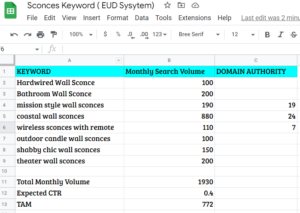
4. . If you don’t know the conversion rate, you can use a rough estimate of the expected conversion rate. In this example, we used a 1% (“0.01” in the spreadsheet) – but keep in mind this will vary a lot from one business to the other. Enter another row, for “Expected Conversion Rate”. If you already know the conversion rate of your pages, use it for this row as a first approximation
5. Add another row for “Total Monthly Conversions” and use the same principle as you did when you calculated the “Total Monthly Volume” (multiply “TAM” by the “Expected Conversion Rate”).
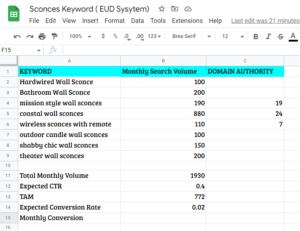
- Enter another row for “Top Line Revenue” (gross revenue you would make with each conversion) and another one for “Bottom Line Revenue” (net revenue you would make with each conversion). These numbers vary a lot from one business to another, but for the purpose of our example, we used $10,000 for Top Line and $5,000 for Bottom Line.
- Create two new rows, one for the “Monthly Top Line” and one for the “Monthly Bottom Line” and calculate them by multiplying “Monthly Conversions” with the “Top Line Revenue”, respectively with the “Bottom Line Revenue”.
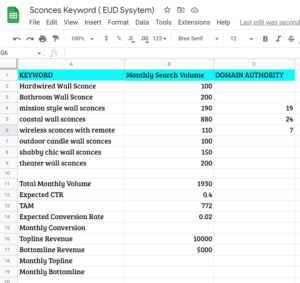
8. Keep in mind: these calculations depend on a lot of variables (for starters, the average monthly searches, which could be off – or your conversion rate, which may vary a lot from one business to another, and one location to another). So, this is just back-of-the-envelope valuation – but it can at least give you an idea on what you could do with a properly optimized website
You’re (never) done!
We said this from the start: doing keyword research and mapping them is not a difficult task. But it definitely is time-consuming. Be thorough and unforgiving. Do it until your eyes bleed, until your friends don’t recognize you anymore, until your kids have gone off to college and you didn’t even notice.
It’s a never-ending process, to be honest – precisely because there will always be opportunities in search. Searcher intents change. Trends change. Keywords change as well. Thus, your SEO strategy should adapt to the new waves too – and this is
why it is crucial that you go through the same research and mapping process again, on a recurrent basis, with the same amount of relentlessness and determination.



